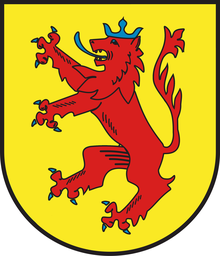Waldgrave: Difference between revisions
Appearance
Content deleted Content added
Gankbank789 (talk | contribs) m Updated short description Tags: Manual revert Mobile edit Mobile app edit iOS app edit App description change |
|||
| Line 7: | Line 7: | ||
The first '''Waldgraves''' or '''Wildgraves''' (Latin: ''comites silvestres'') descended from a division of the House of the [[Emichones|Counts of Nahegau]] in the year 1113. |
The first '''Waldgraves''' or '''Wildgraves''' (Latin: ''comites silvestres'') descended from a division of the House of the [[Emichones|Counts of Nahegau]] in the year 1113. |
||
When the {{lang|de|[[Nahegau]]|italic=no}} (a countship named after the river [[Nahe (Rhine)|Nahe]]) split into two parts in 1113, the counts of the two parts, belonging to the [[House of Salm]], called themselves [[Wildgrave]]s and [[Raugrave]]s, respectively. They were named after the geographic properties of their territories: Wildgrave ({{ |
When the {{lang|de|[[Nahegau]]|italic=no}} (a countship named after the river [[Nahe (Rhine)|Nahe]]) split into two parts in 1113, the counts of the two parts, belonging to the [[House of Salm]], called themselves [[Wildgrave]]s and [[Raugrave]]s, respectively. They were named after the geographic properties of their territories: Wildgrave ({{langx|de|Wildgraf}}; {{langx|la|comes sylvanus}}) after {{lang|de|Wald}} ("forest"), and Raugrave ({{langx|de|Raugraf}}; {{langx|la|comes hirsutus}}) after the rough (i.e. mountainous) terrain.<ref>{{Meyers Online|13|0605|spezialkapitel=Raugraf}}</ref> |
||
== References == |
== References == |
||
Latest revision as of 06:08, 24 October 2024
This article needs additional citations for verification. (July 2021) |


The first Waldgraves or Wildgraves (Latin: comites silvestres) descended from a division of the House of the Counts of Nahegau in the year 1113.
When the Nahegau (a countship named after the river Nahe) split into two parts in 1113, the counts of the two parts, belonging to the House of Salm, called themselves Wildgraves and Raugraves, respectively. They were named after the geographic properties of their territories: Wildgrave (German: Wildgraf; Latin: comes sylvanus) after Wald ("forest"), and Raugrave (German: Raugraf; Latin: comes hirsutus) after the rough (i.e. mountainous) terrain.[1]
References
[edit]- ^ Raugraf. In: Meyers Konversations-Lexikon. 4th edition. Volume 13, Verlag des Bibliographischen Instituts, Leipzig/Vienna 1885–1892, p. 0605.
